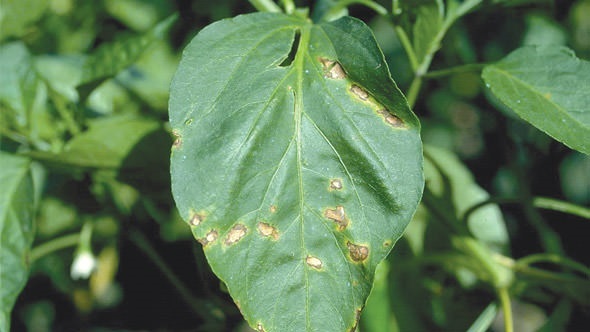How To Keep Your Cool When Under Fire On The Farm
Angela Lindsey of the University of Florida Institute of Food and Agricultural Sciences (UF/IFAS) has five simple words for growers who are implementing a crisis management plan: “Prepare, prepare, and prepare again.”
 Lindsey, an assistant professor in the Family, Youth and Community Sciences Department says fruit and vegetable growers, because of the potential for a widespread outbreak of foodborne illness, face some of the greatest challenges.
Lindsey, an assistant professor in the Family, Youth and Community Sciences Department says fruit and vegetable growers, because of the potential for a widespread outbreak of foodborne illness, face some of the greatest challenges.
“You have to have a plan in place before a crisis begins, because in your business you face a lot of risk,” Lindsey, who holds an appointment at the UF/IFAS Center for Public Issues Education (PIE) in Agriculture and Natural Resources, says. “Call a sit-down ad hoc committee together and discuss some of the worst-case scenarios. Don’t hold back, and be as specific as possible.”
Lindsey’s colleague, Nicole Dodds, a PIE outreach and training coordinator, prepared a checklist for leaders who could potentially face a crisis. It’s broken down into three main parts, preparation, communication during the crisis, and evaluation after a crisis. Lindsey elaborated on some of the key points contained within the checklist.
√ Preparation
Organize a what-if brainstorming situation. What can go wrong? Make it exhaustive as you can. If it’s worse than what happens, you’re prepared. Most organizations don’t realize what the extent of the crisis can be.
Select a crisis management team. Who talks to the media? Who will be your one spokesperson? That person knows it and is highly trained. “Personally, I think it should be someone high up in the organization as possible,” Lindsey says. “I’m a big proponent of having someone as high up in the organization as possible, because it builds credibility with the public.”
ID your key audiences. How do they get information? Do you need a phone tree or do they prefer social media? If your plan is based on your website and social media but you have a store chain that doesn’t use those, what good is that?
You want all the information to come from one source, so designate a crisis leader. Usually it’s your PR or communications person. They should have a checklist, and they will be barking orders. You want a single crisis hub, and you want someone to manage that hub for you.
Anticipate tough questions. Make a list and be ready to respond to them. This is where the media training comes in and is so important. You don’t get in front of camera and get asked questions you’re not prepared to answer. “Don’t underestimate the power of a camera in your face,” she says. “It can be intimidating in a crisis. Especially if folks are injured — that’s tough.”
♦ Go to the next page to find out what you need to do during and after a crisis ♦
 √ Communication During Crisis
√ Communication During Crisis
You will have to deal with the media. Have a key message. Know it. “It can be simple: ‘We are very sorry, and we’re going to do everything in our power to fix this. We’ll be in communication with you until it is resolved,’” Lindsey says. “Keep going back to that key message. Drive it home.”
Gather information, and decide between facts and rumors. Facts should be updated. Don’t repeat hearsay, but you want to make sure the hub is continually updated. It’s an internal feedback loop. Internal communication is vital to making sure external communication is effective.
Develop clear, simple messages for the media that come from one person. “Basically, the hub person develops key messages and then gives them to the CEO or whomever to communicate to the media,” she says. “However, those key messages should go out to everybody in your organization. You want to have unified front.”
Provide graphics. Diagrams help illustrate points, especially with produce, where it may be a complicated scientific message that is hard to communicate. “Build a website, called a dark site, that doesn’t go live until there is a crisis,” Lindsey says. “I’m a big fan of dark sites. Everything is already on. You can put those infographics on there and have them ready to go.”
Be active, not reactive. Tell it all and tell it fast. “Definitely be as proactive as possible,” she says. “You want to get a statement out there before someone makes a statement for you. And the best way to do that is to be prepared.”
Don’t say “No Comment.” It sounds like you’re hiding something. Instead, say “I don’t know, but I’ll find out.”
Write everything down; it’s great for evaluation. Taking photos is always good. Most everyone has a camera on their phone. Remember to use it, but be respectful and think about privacy issues. Definitely if someone is injured.
√ Post-Crisis Evaluation
Take a deep breath, but it’s no time to relax, because it’s the best time to review how you’ve done.
Why did the crisis occur? Could the crisis have been prevented? After a crisis, you need to have a major meeting. Start with the basics. What happened, exactly? Why did it happen? Also, evaluate your crisis plan. What went well? What didn’t go well? Why?
How was the crisis handled? What would you do differently? Be constructive. Going through one of these crises is the best way to learn, unfortunately. Makes sure the details are captured in the plan right afterward. Evaluate the plan routinely twice a year, but also do it after a crisis. Do run-throughs.
What would you do in a similar situation in the future? What have others done? Benchmarking and looking at case studies of others is especially valuable if you’ve never had a crisis. Contact other companies. Industry associations can be extremely valuable in providing crisis management information.








